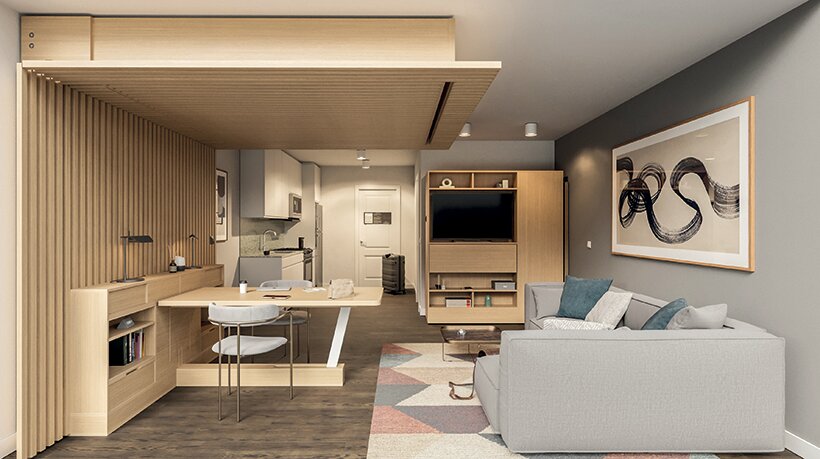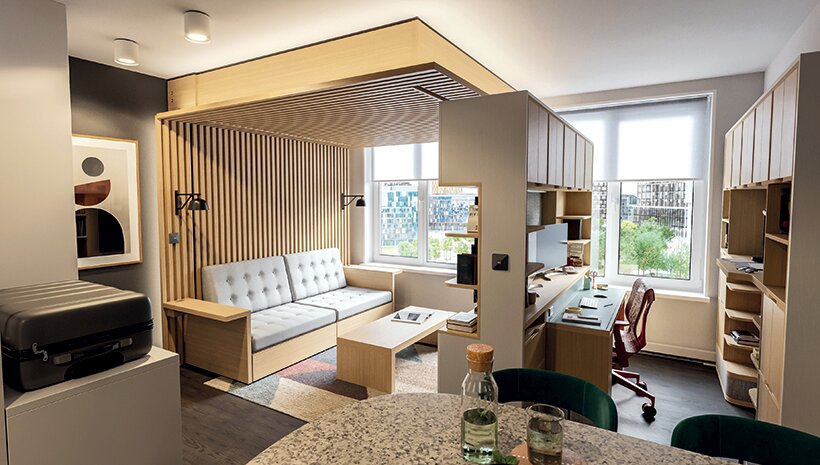What the hotel room of the future will look like
Imagine a bed that lifts into the ceiling to reveal a comfortable sofa, a table for dinner or a desk. When a guest is ready to sleep, a push of a button sees a closet slide out from the wall to reveal a walk-in wardrobe, while the desk’s supporting leg folds into the floor, lowering the tabletop to allow the bed to gracefully drop down from the ceiling.
Some may think of a glorified murphy bed, but when paired with smart home technology, a room can be transfigured at the touch of a button, the sound of your voice or a swipe of your phone. Could the Cloud Bed – Table Edition and the accompanying Pocket Closet be the future of the hotel room?
Hasier Larrea certainly thinks so. He founded robotic furniture company Ori – as in origami – which began as a research project out of the famed Massachusetts Institute of Technology in the US. Larrea wanted to create a solution to the overcrowding in cities by rethinking the footprint of a typical apartment and creating spaces that are larger than they first seem.

“People don’t need as much space as they think they do,” he says. “And this design helps with sustainability and affordability challenges as these are proportional to the square footage you need – the more steel or space you need for air conditioning, the more you have to pay.”
He's now taking his design from residential real estate into hospitality with a partnership with Marriott. The two brands are working together as part of Marriott’s Design Lab to reimagine a typical hotel room and provide travellers with a multi-functional space.
“The brief was to shrink the square footage of a typical room, but not shrink the functionality,” he says. “It’s giving people more space by giving people more square footage. I’m not sleeping right now, so I have a full office – it’s more than having a room with a bed in the middle.”

Larrea says there’s a requirement for adaptability: “A hotel room may be an office during the week, but how can you achieve that without renting a suite?”
There are three components to the technology, which Larrea calls the skeleton, muscle and the brain. “The skeleton is the mechanism, which isn’t where the innovation lies because we’ve been moving things for centuries. Add the muscle, with electronics and motors, which removes the manual element, but the real magic is the brain, which is the lines of code and programming to allow things to move safely and effortlessly and connect to other smart home devices.”
While the technology is not currently available in any of Marriott’s hotels, Larrea says it shouldn’t be long, saying the design is not for the “long-term future, but the near future”.
“The technology is ready, we’re in hundreds of apartments, soon to be thousands. But to bring it into hospitality there’s a process because it’s a new vertical of real estate. Marriott has multiple brands which need to be analysed to decide which solutions make the most sense.”
Once hospitality gives the design the green light, the Cloud Bed can be assembled in a few hours. “It’s like flatpack furniture and it anchors to the wall similar to a shelf.” And cost? Depending on the finishes, with designs ranging from simple soft furnishing to Scandinavian wood panelling, hotels can pick up individual Ori systems for between $5,000-$12,000 (£3,960-£9,504) if bought at volume.















